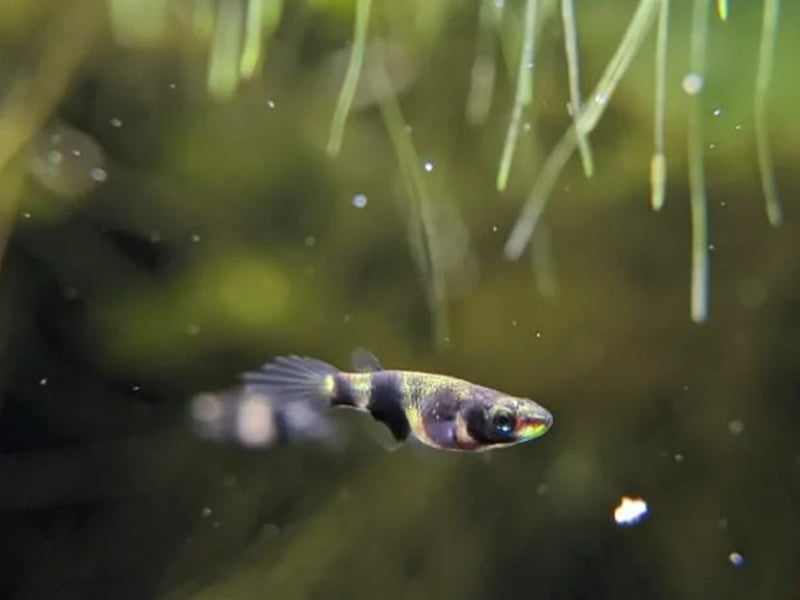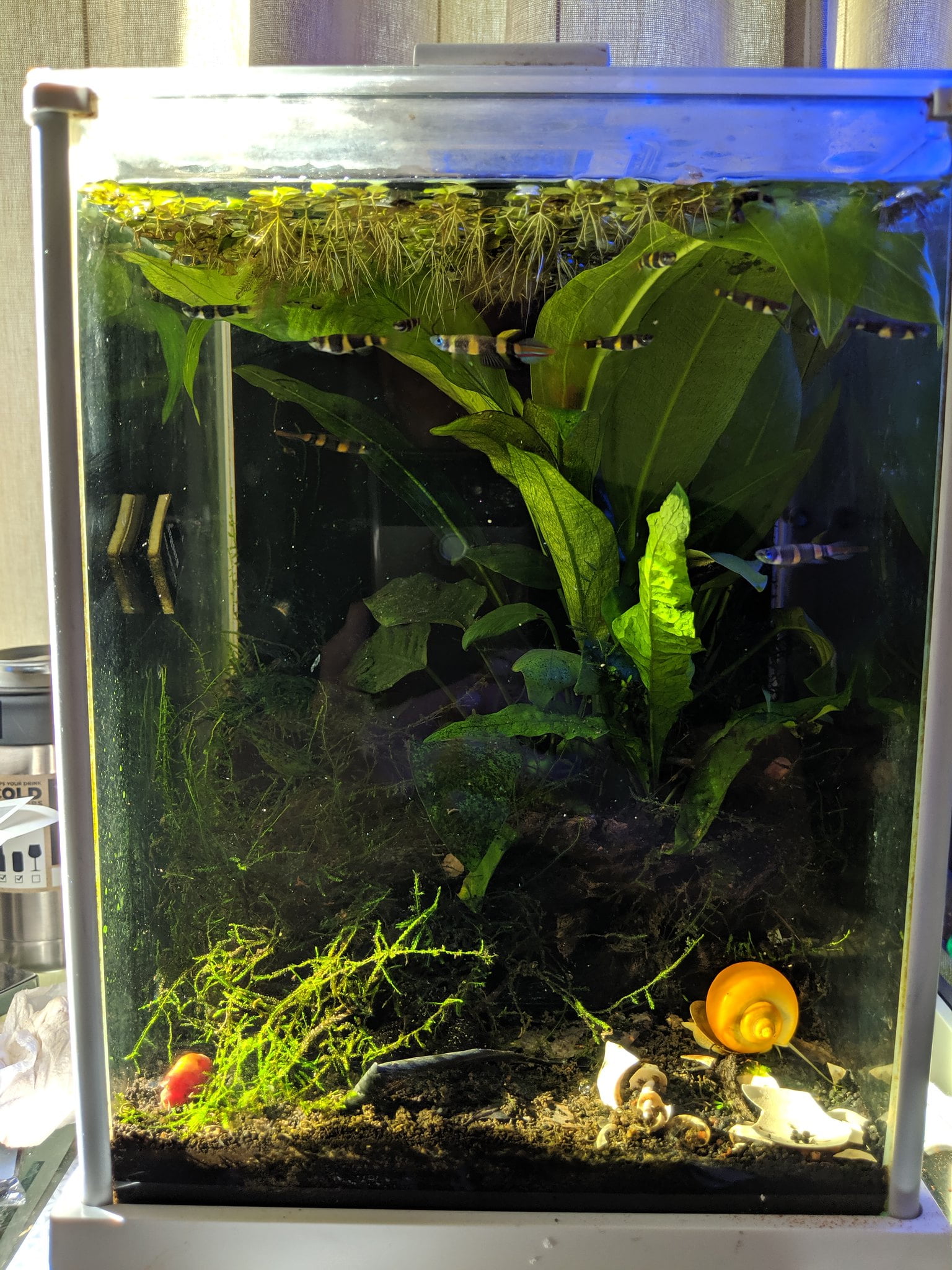How to know your Killifish is pregnant? What are the useful tips to keep your pregnant Clown Killifish healthy and don’t limit their production? And what is the right way to comfort them?
All information you need will be explained now.
Related Articles
- Clown Killifish With Shrimp: Can They Live Safely Together?
- Clown Killifish Temperature: 4 Ways It Makes Impact & How To Keep Them Be Strong
- How Many Clown Killifish In 5 Gallon? The Complete Guide To Tank Setup And Tank Mates
Overview
A Clown Killifish (Epiplatys annulatus) can be called Banded Panchax or Rocket Killifish. They were given the nickname “Rocket” because their tales resemble the flame from a rocket, particularly in males.
Their tail fins are spade-shaped with long rays, and their heads are round. They attain a maximum length of 1.2-1.4 inches when fully grown and have an average lifespan of 3-5 years, though this is highly dependent on the environment, nutrition, tank conditions, and tankmates. They have a short lifespan but aren’t an annual variety. Their vibrant pattern in black, blue, yellow, or orange and their upbeat movement will immediately capture your eye.
Killifish are members of the family Nothobranchiidae and are found in tropical freshwater settings throughout West Africa, Liberia, Guinea, and Sierra Leone.
Clown Killifish are carnivores and predators, which means they prefer live food and will typically avoid frozen food or pellets. They prefer to feed on fruit flies or blood worms that have been diced up.
How can I determine the gender of a Clown Killifish? Male clown killifish are typically more vibrantly colored and conspicuous than female clown killifish. Female clown killifish have a more subdued color scheme than males, and their size difference also helps distinguish them. Additionally, males have slightly longer fins than females.
More clown killifish of the same species are excellent tankmates for clown killifish. They are a very social species and should be kept in groups of at least eight individuals. Male individuals of the species frequently chase and spar with one another, but it’s harmless fun. Clown Killifish appreciate peaceful, tiny fish as tankmates; tetras or minnows are acceptable choices.
How To Know Is Your Clown Killifish Pregnant Or Not?

All Killifish are egg scatterers, not livebearers, so they will not get pregnant.
They deposit their eggs in moss or other vegetation every few days, and the eggs are exceedingly little; they hatch in about two weeks. It’s unlikely that your parents will consume their eggs or fries, but you should watch out. Eggs should be kept apart from mature Clown Killifish and youngsters because juveniles can eat newly hatching eggs.
Their eggs have a lifespan of up to nearly two years. This very long period is due to their origins in places where rainfall is inconsistent and periodically skips a year. The eggs must be capable of surviving until the following rainy season.
So, what is the ideal environment for female Clown Killifish to lay eggs?
The Ideal Environment For Reproduction: Completed Guide
Tank Requirement
They appear to do fine in a five-gallon tank, but a larger one is certainly an option as well. Large and small tanks have their advantages and disadvantages. A larger tank with other species will limit Clown Killifish reproduction, therefore the smaller tank may be better for breeding Clown Killifish fry if that’s what you’re looking for.
But, you may aware of this thing. Clown Killies cannot survive in the strong currents produced by a filter in a smaller tank. Both have their own benefits, so which decision is depending on you.
A well-designed tank with floating plants will undoubtedly reap the greatest benefits. Plants will assist keep the tank clean; they will provide a nesting area for Clown Killifish, provide cover for the fry, and provide vital hiding spots for the shy adult Clown Killifish.

Guppy Grass (beware of overgrowth), Java Ferns, Water Lettuce, and Water Sprites are also excellent plant choices. Clown Killies will also benefit from the addition of driftwood to their aquarium. Moreover, you should include Java moss and a little amount of peat for use as a substrate.
In order to keep our Clown Killifish happy, especially the female, make sure the lighting is dim and the water flow is slow or nonexistent. As a result, they will appreciate the presence of streams and marshes that resemble those in their native Africa. The strong movement will make them stressed. Additionally, please remember to perform a weekly partial water change of around 30%.
Water Condition
Clown Killifish prefer soft, warm, and acidic water in the wild.
Precondition the water before inserting the fish. Add tank water to a separate container and soak peat in a box filter for a few days. The water will acquire an amber hue, which is ideal for the Clown Killifish.
To ensure a close resemblance to their native habitat, the optimum parameters are as follows:
- pH levels: 4-7
- Water hardness: 4-8 dKH
- Water temperature: 68° – 79° F (20° – 26° C)
Tankmates
Small groupings of these Killifish are excellent for their well-being. You can have two or three pairs of fish in a two-gallon tank, or even up to eight pairs in a ten-gallon tank because the fish tend to pair off naturally. During spawning, you may see some fighting amongst male Killis, despite their generally peaceful nature.
It is possible to have a good tankmate for them with the following little and calm fishes:
- Small Barbs
- Small Plecos
- Some Varieties Of Tetras
- Bettas
- Corydoras Catfish
- Danios
- Gouramis
- Minnows
Diet
Clown Killifish are carnivorous, as I had said before. In order to satisfy their need for prey, feed live fruit flies, mosquito larvae, or very small confused-flour beetle larvae. Small daphnia, copepods, and nematodes are also favorites of these fish. Some Killifish will consume frozen food, but most prefer live food and will not be lured by flakes or frozen food.
Video: Clown Killifish Care Guide
FAQs
How often do Clown Killifish breed?
Clown Killifish have babies every few weeks, and per two pairs of adults can have up to 50 babies.
How do Clown Killifish breed?
If both sexes are in the same tank, Clown Killis are very easy to breed. Fry just appears in a well-planted tank when both sexes are in it. Mosses, the roots of floating plants, or synthetic spawning mops are places where adults will put their eggs when they’re done having babies, Only use a sponge filter for filtration if you don’t want to get rid of the fry.

Annette M. Chaney is an experienced marine biologist with over 20 years of experience as an aquarist and fishkeeper. She started her first aquarium at a young age, filling it with frogs and goldfish obtained from the ten-cent pet store.
Annette grew up caring for and breeding African Cichlids, which led to a hobby in high school that doubled as a profitable means. Attending Reed College gave her time to solidify herself as an accomplished aquarium caretaker with an eye for sales. After that, from 2009 – 2013, she studied at Roger Williams University – one of the most prestigious universities for Aquaculture and Aquarium in USA. She is the founder of AquariumCircle since 2010.
